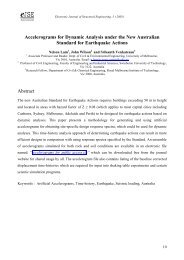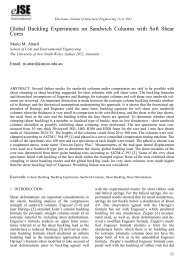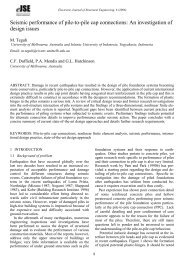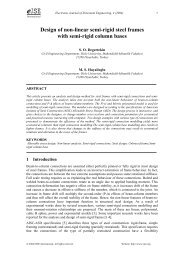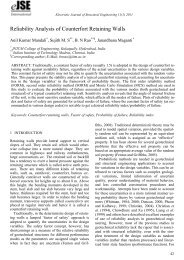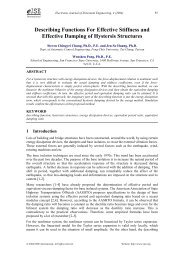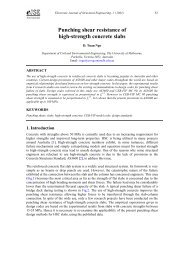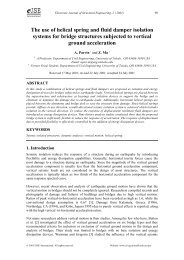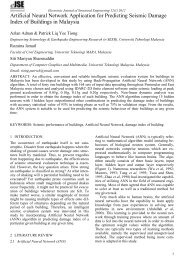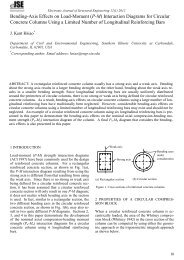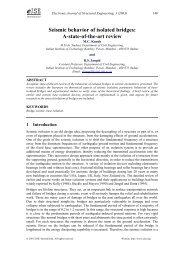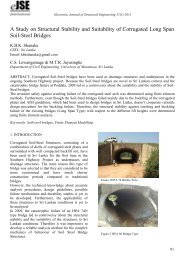Create successful ePaper yourself
Turn your PDF publications into a flip-book with our unique Google optimized e-Paper software.
The Maximum Saved Steps controls the number of significant events for which data<br />
will be saved. The program will always reach the force or displacement goal within<br />
the specified number of maximum saved steps, however, in doing so it could have to<br />
skip saving steps at later events. For example, suppose the Minimum Saved Steps is<br />
set to 20, the Maximum Saved Steps is set to 21, and the pushover is to be to a<br />
displacement of 10 inches. The maximum increment of saved steps will be 10 / 20 =<br />
0.5 inches. Thus, data is saved at 0.5, 1, 1.5, 2, 2.5 inches. Suppose that a significant<br />
event occurs at 2.7 inches. Then data is also saved at 2.7 inches, and continues on<br />
from there being saved at 3.2 and 3.7 inches. Suppose another significant event<br />
occurs at 3.9 inches. The program will not save the data at 3.9 inches because if it<br />
did it would not be able to limit the maximum increment to 0.5 inches and still get<br />
through the full pushover in no more than 21 steps. Note that if a second significant<br />
event occurred at 4.1 inches rather than 3.9 inches, then the program would be able<br />
to save the step and still meet the specified criteria for maximum increment and<br />
maximum number of steps.<br />
The Maximum Failed Steps is used, if necessary, to declare failure (i.e., nonconvergence)<br />
in a run before it reaches the specified force or displacement goal. The<br />
program may be unable to converge on a step when catastrophic failure occurs in the<br />
structure. There may also be instances where it is unable to converge on a step due<br />
to numerical sensitivity in the solution. The Maximum Failed Steps is a cumulative<br />
counter through the entire analysis. If the Maximum Failed Steps is reached, the<br />
analysis stops.<br />
The Event Force Tolerance and the Event Deformation Tolerance are ratios that are<br />
used to determine when an event actually occurs for a hinge. Consider the figure that<br />
shows the location of<br />
two hinges on their<br />
force-displacement<br />
plots. Hinge 1 has<br />
reached an event<br />
location. For hinge 2,<br />
if both the Event Force<br />
Tolerance and the<br />
Event Displacement<br />
Tolerance are met,<br />
then the hinge is within<br />
event tolerance and it<br />
too will be treated as<br />
part of the event. In<br />
Force<br />
A<br />
B<br />
Yield force<br />
Displacement<br />
the figure, if the Force Tolerance divided by the Yield Force is less than the Event<br />
Force Tolerance specified in the Static Pushover Case Data, and the Displacement<br />
Tolerance divided by the horizontal distance from B to C is less than the<br />
Displacement Event Tolerance specified in the Static Pushover Case Data, then hinge<br />
2 will be treated as part of the event. When determining the Force Tolerance Ratio,<br />
D<br />
C<br />
Assume hinge 2 is at this point<br />
on its force-displacement curve<br />
Assume hinge 1 is at this point<br />
on its force-displacement curve<br />
Force tolerance<br />
Displacement tolerance<br />
E<br />
<strong>SAP2000</strong> <strong>Web</strong> <strong>Tutorial</strong> 1 100



